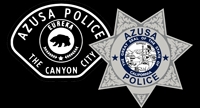On September 16th, 2014, a new law came to California, known as the "3 Feet For Safety Law." The purpose of this law is to save the lives of bicyclists as they use our beautiful roadways for commuting, exercising and recreation. It is the intention of the Azusa Police Department to support this law through both educational and enforcement means.
What Is The "3 Feet For Safety Law"?
This law essentially states that motorists will leave 3' between their vehicle and any part of a bicyclist, as they pass the bicyclist traveling in the same direction. There are some further directions, as outlined in California Vehicle Code Section 21760, which states:
21760 (a) This section shall be known and may be cited as the Three Feet for Safety Act.
(b) The driver of a motor vehicle overtaking and passing a bicycle that is proceeding in the same direction on a highway shall pass in compliance with the requirements of this article applicable to overtaking and passing a vehicle, and shall do so at a safe distance that does not interfere with the safe operation of the overtaken bicycle, having due regard for the size and speed of the motor vehicle and the bicycle, traffic conditions, weather, visibility, and the surface and width of the highway.
(c) A driver of a motor vehicle shall not overtake or pass a bicycle proceeding in the same direction on a highway at a distance of less than three feet between any part of the motor vehicle and any part of the bicycle or its operator.
(d) If the driver of a motor vehicle is unable to comply with subdivision (c), due to traffic or roadway conditions, the driver shall slow to a speed that is reasonable and prudent, and may pass only when doing so would not endanger the safety of the operator of the bicycle, taking into account the size and speed of the motor vehicle and bicycle, traffic conditions, weather, visibility, and surface and width of the highway.
(e) (1) A violation of subdivision (b), (c), or (d) is an infraction punishable by a fine of thirty-five dollars ($35).
(2) If a collision occurs between a motor vehicle and a bicycle causing bodily injury to the operator of the bicycle, and the driver of the motor vehicle is found to be in violation of subdivision (b), (c), or (d), a two-hundred-twenty-dollar ($220) fine shall be imposed on that driver.
(f) This section shall become operative on September 16, 2014.
Cyclists Have An Obligation As Well
Just as motorists will do their part to follow the new law, it is imperative for the cycling community to follow the law as well. For purposes of this topic, we'll be focusing on the the law regarding the position of a bicycle on a roadway. Although the law specifies cyclists are to ride as close as practicable to the right-hand curb or edge of the roadway, this is often misunderstood by the motoring public. In this case, “practicable” means, as close the right edge as is safe and reasonable under existing or probable conditions. This is quite different from, nor does it mean, as close as possible to the right hand curb or edge of the roadway. Who better to judge what is considered safe for a cyclist than the cyclist himself?
Often times, a cyclist will ride several feet away from a curb, so as to make their presence known. Too often, motorists pass extremely close to cyclists, and most likely don't see the cyclist until the last moment. Depending on the roadway, a cyclist may ride in a manner which causes the motorist to change lanes to pass. This is far better to do than passing a cyclist with less than 3 feet.
Per section 21202 of the California Vehicle Code, cyclist are to ride as close as practicable to the right-hand curb or edge of the roadway, unless certain conditions exist as specified in the full sample of the code below:
(a) Any person operating a bicycle upon a roadway at a speed less than the normal speed of traffic moving in the same direction at that time shall ride as close as practicable to the right-hand curb or edge of the roadway except under any of the following situations:
(1) When overtaking and passing another bicycle or vehicle proceeding in the same direction.
(2) When preparing for a left turn at an intersection or into a private road or driveway.
(3) When reasonably necessary to avoid conditions (including, but not limited to, fixed or moving objects, vehicles, bicycles, pedestrians, animals, surface hazards, or substandard width lanes) that make it unsafe to continue along the right-hand curb or edge, subject to the provisions of Section 21656. For purposes of this section, a “substandard width lane” is a lane that is too narrow for a bicycle and a vehicle to travel safely side by side within the lane.
(4) When approaching a place where a right turn is authorized.
(b) Any person operating a bicycle upon a roadway of a highway, which highway carries traffic in one direction only and has two or more marked traffic lanes, may ride as near the left-hand curb or edge of that roadway as practicable.
Have Questions?
Please visit our Facebook page at Facebook.com/AzusaPD and click on any of the posts about this law, to submit a comment. You can also visit our forum here on our website.
"If we both do our part, we can safely enjoy Azusa's beautiful roadways together, as a community."
